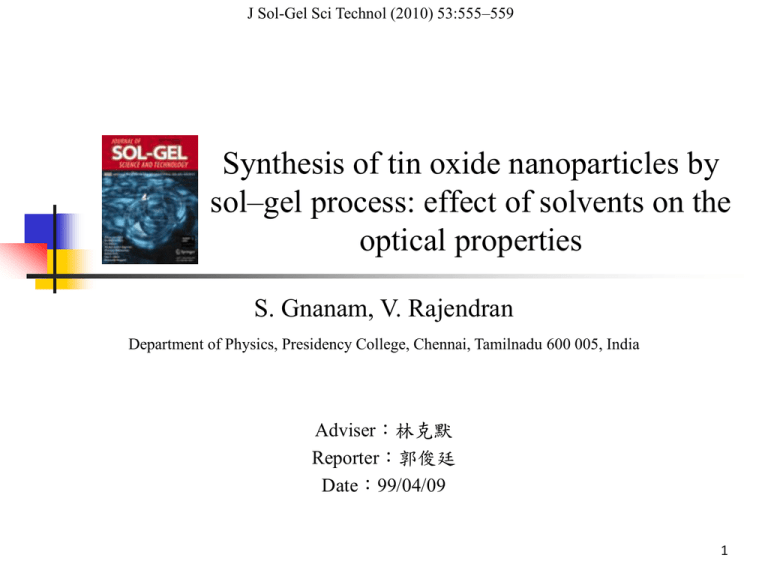Synthesis of tin oxide nanoparticles by sol–gel process: effect of
advertisement

J Sol-Gel Sci Technol (2010) 53:555–559 Synthesis of tin oxide nanoparticles by sol–gel process: effect of solvents on the optical properties S. Gnanam, V. Rajendran Department of Physics, Presidency College, Chennai, Tamilnadu 600 005, India Adviser:林克默 Reporter:郭俊廷 Date:99/04/09 1 Outline Introduction Experimental procedure Results and discussion Conclusion 2 Introduction Tin oxide (SnO2), with a rutile-type crystalline structure, is an n-type wide band gap (3.6 eV) semiconductor that presents a proper combination of chemical, electronic and optical properties that make it advantageous in several applications[3]. Nanostructured SnO2 particles have been prepared by using different chemical methods such as precipitation, hydrothermal, sol-gel, gel-combustion and spray pyrolysis[12– 19]. 3 A sol–gel process offers several advantages over other methods, better homogeneity, controlled stoichiometry, highpurity, phase-pure powders at a lower temperature and flexibility of forming dense monoliths, thin films or nanoparticles. In general, the band gap increases with the decrease of particle sizes if the particle size is lower than the critical size (which forms excitons in semiconductor). As particle size decreases, surface to volume ratio increases and more traps (holes or electrons or excitons) are developed in smaller particles. 4 The physical state of tin oxide nanocrystalline, e.g., the grain size and morphology, is very important on its electronic and optical properties. The gas sensitivity, for example, increases sharply with the decrease of the diameter of tin oxide below a critical value (6 nm)[22]. The main purpose of the present research is to study the influence of solvents on the size, morphology and hence, optical properties of the synthesized nanomaterials were investigated. 5 Experimental procedure In a typical synthesis, a transparent sol solution was prepared by dissolving 3.5 g of tin tetrachloride pentahydrate (SnCl4‧5H2O) in 100 mL methanol (CH3OH) under vigorous stirring. 4 mL of an aqueous ammonia solution was added to the above solution by drop wise under stirring. The resulting opal gels were filtered and washed with methanol to remove impurities, and dried over 80℃ for 5 h in order to remove water molecules. Finally, ash colored tin oxide nanopowders were formed at 400℃ for 2 h. 6 The XRD pattern of the SnO2 powder was recorded by using a powder X-ray diffractometer (Schimadzu model: XRD 6000 using CuKα (α = 0.154 nm) radiation, with a diffraction angle between 20 and 80°. The crystallite size was determined from the broadenings of corresponding X-ray spectral peaks by using Debye– Scherrer’s formula. The Fourier transform infrared (FTIR) spectra of the samples were taken using a FTIR model Bruker IFS 66 W Spectrometer. 7 UV–Vis absorption spectra for the samples recorded using a Varian Cary 5E spectrophotometer in the range of 200–800 nm for the powder samples (calcined at 400℃) in Nujol mode. The photoluminescence (PL) spectra of the SnO2 were recorded by Perkin-Elmer lambda 900 spectrophotometer with a Xe lamp as the excitation light source. Scanning Electron Microscopy (SEM) studies were carried out on JEOL, JSM-67001. Transmission electron microscope (TEM) images were taken using an H-800 TEM (Hitachi, Japan) with an accelerating voltage of 100 kV. 8 Results and discussion All samples present wide diffraction peaks at the same position, which can be indexed to the tetragonal rutile structure of SnO2 (JCPDS card no.88-0287). Using Scherer’s formula the average crystallite sizes of the SnO2 nanocrystals obtained from methanol, ethanol and water were found to be 3.9, 4.5 and 5 nm, respectively. 9 The broad envelop in the higher energy region about 3,500 cm-1 is due to –OH vibration of methanol and that of water absorbed on the SnO2 particle surface. Presence of alcohol is also evident by its C–H stretching vibration just below 3,500 cm-1 and it is bending vibration at about 1,450 cm-1. 10 The CH3–O vibration of methanol gives a sharp intense peak at about 1,010 cm-1. The broadband in the lower energy region is assigned to Sn– O vibration. The FTIR spectrum of SnO2 calcined at 400℃ is shown in Fig. 2b. As the broadband in the higher energy region in Fig. 2a. is completely lost in the spectrum, both CH3–O and –OH are expelled during calcination. However, the peak at 602 cm-1 is assigned to SnO2 vibration, which indicates that the products are well crystallized. 11 This is because methanol functions as a spacer to modulate distance between metal ions preventing metal oxide particles from aggregation during earlier stages of organics removal. 12 The obvious rings of selective area electron diffraction (SAED) in the inset of Fig. 4. indicate that all the products are polycrystalline. Figure 4a shows methanol mediated SnO2 nanoparticles with spherical morphology of size about 3 nm. 13 Comparing to that of methanol, slightly elongate nanoparticles of SnO2 nanocrystallites were obtained and the size of the products were increased to ca. 4.5 and 5 nm. Moreover, the particle sizes of all the samples obtained from TEM patterns are quite similar to those calculated from Scherrer’s equation. 14 It shows clear lattice fringes, indicating the established crystallinity of SnO2 powders. 15 The as-prepared methanol mediated SnO2 nanoparticles has the absorption edge is at 312 nm, which is smaller than the band edges observed at 323 and 337 nm for ethanol and water. 16 Considering the blue shift of the absorption positions from the bulk SnO2, the absorption onsets of the present samples can be assigned to the direct transition of electron in the SnO2 nanocrystals. The corresponding band gap energies can be calculated to be 3.97, 3.83 and 3.68 eV and are larger than the bulk SnO2[24]. The increasing trends of the band gap energy upon the decreasing particle size are well presented for the quantum confinement effect. 17 High intensity signal in the UV region and low intensity in the visible region in PL spectrum indicate a good surface morphology of SnO2 nanoparticles. 18 A sharp UV emission peak was observed at 345 nm (Fig. 6a), which attributed to the radiative annihilation of excitons. Two prominent peaks at 467 and 400 nm have been observed in the range 350–500 nm. Particularly, the peak position at 467 nm is sharp and unchanged for all samples whereas its intensity tends to reduce with heat treatment temperature. It is due to the characteristics of the traps present in the nanoparticles[24]. We attribute the emission at 440 nm to electron transition mediated by defects levels in the band gap, such as oxygen vacancies. 19 In the present SnO2 nanocrystals, the intrinsic defects, such as oxygen vacancies, which act as luminescent centers, can form defect levels located highly in the gap, trapping electrons from the valence band to contribute to the luminescence. 20 Conclusion 利用甲醇、乙醇和水所製備的SnO2奈米顆粒,透過TEM 與XRD的證實,其顆粒大小分別為3.9、4.5和5nm。 SnO2奈米結晶性的表面型態主要取決於溶液。 考慮SnO2塊材藍移的吸收位置,本期刊所製備出的SnO2 奈米顆粒的吸收峰歸咎於奈米顆粒中電子的直接躍遷。 SnO2奈米結晶中的本質缺陷,像氧空缺,會在禁止帶中 形成一個缺陷能階(偏導帶)捕捉價帶的電子,作為一個輻 射複合中心提供螢光。 從SEM與TEM觀察得知,用甲醇製備出球型的SnO2奈米 顆粒尺寸約3nm。 21 經由不同的溶劑所製成的SnO2奈米顆粒,對顆粒尺寸、 表面形態和光學特性的效應有不同的影響。 22 Thanks for your attention 23


